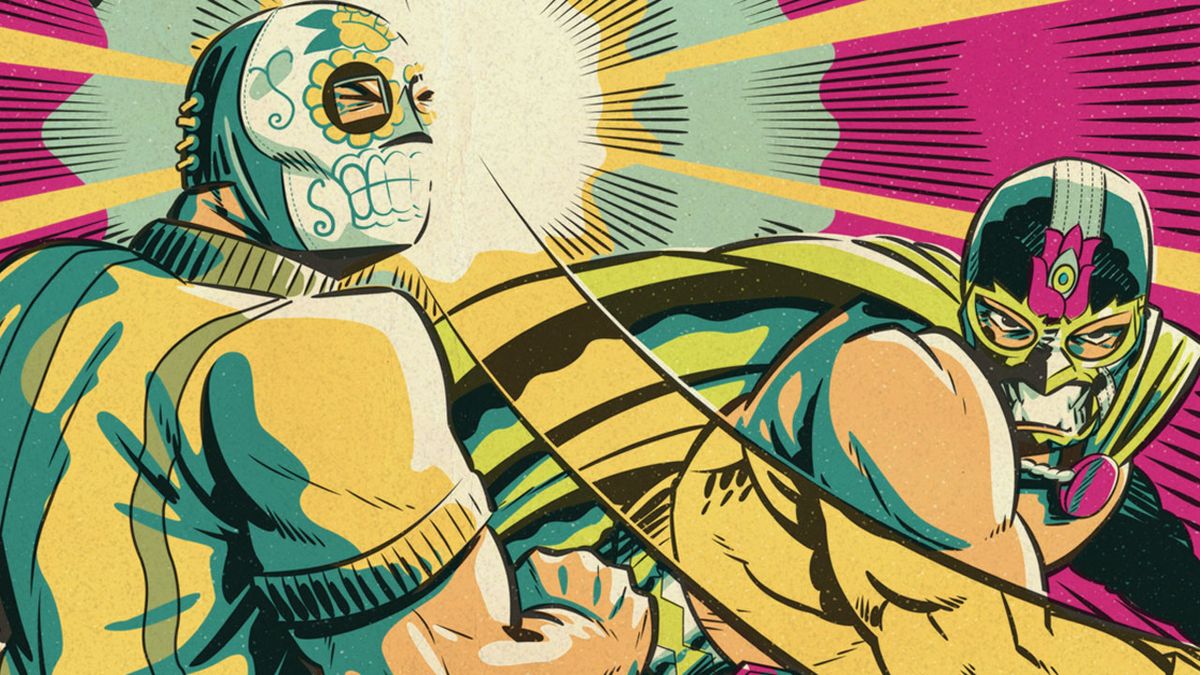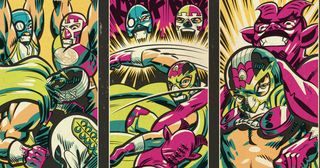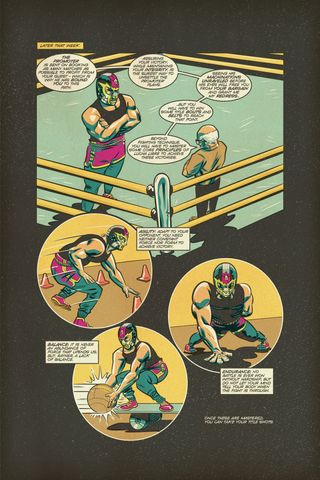La Mano del Destino brings authentic Lucha Libre culture to comics
Get swept up in the vibrant pageantry of authentic Lucha Libre culture with La Mano del Destino

Get swept up into the vibrant culture of authentic Lucha Libre with the upcoming comic collection La Mano del Destino.

Hot off drawing the non-fiction book La Voz de M.A.Y.O.: Tata Rambo, Chicano writer/artist J. Gonzo has created a love letter to the complex and heatfelt pro wrestling sub-genre of Lucha Libre that has everything a superhero fan would want:: a hero, a villain, consequences, and some great costumes.
La Mano del Destino is a Faustian story of a luchador (wrestler) who is robbed of everything he holds dear, and must fight from underneath to get his life back - along with revenge. But when he makes a sinister deal to make the path back a little easier, it might all come back to bite him (and make it worse).
Gonzo originally self-published a serialized version of La Mano del Destino that was sold DIY, but now he's partnered with Image Comics and Top Cow Productions for a 240-page trade paperback edition going on sale May 25. With an advance copy in hand and the release date on its way, Newsarama spoke with Gonzo from his Phoenix, Arizona home about the book (and the hero) El Mano del Destino and the vibrant culture of Lucha Libre it represents.
Newsarama: Gonzo, who is La Mano del Destino as this comic begins - before he makes the deal with a proverbial devil?

J. Gonzo: We see through flashbacks that la Mano del Destino was an orphaned street kid named Ernesto who lived near the bottom rungs of the Mexican class system of the '40s. Through various circumstances, he and his older brother are sent to live with their hometown's don (wealthy, land-owning patriarch) who is also a petty tyrant known as el General.
After some time under the care of el General, there is an incident that lands both boys in prison and Ernesto sees for the first time what his true station in life is and his brother dies while incarcerated. After his release from prison, Ernesto (with his physique now honed from years of hard labor) decides to earn a living as a luchador.
Sign up to the 12DOVE Newsletter
Weekly digests, tales from the communities you love, and more
He steers clear of the sport's corruption and, over time, becomes a beloved people's champion - he is good-hearted and kind. Ernesto is offered a bribe to take a dive and refuses, but his friends are all too happy to take the money to betray Ernesto, ambush, and unmask him in the ring.
It is in the shame-filled moments after his betrayal and unmasking, that his deal is signed.
Nrama: A luchador being un-masked - especially against his will and not where he puts it on the line in a match - is one of the vilest things that can be done in Lucha libre culture. What does it mean to la Mano del Destino?
Gonzo: To the luchador, this is a complete annihilation of self. To la Mano del Destino, specifically, this is an insult that cannot be left unavenged.

There is no identity beyond the mask; every win, every loss, every title, and every fan that Ernesto had attained are intrinsically woven into the threads of that mask - and they are all now gone. The sacred tradition of the luchador says that he can NEVER be that persona again; when the mask comes off the spell is broken and can't be mended.
Given Ernesto's history of being marginalized and ostracized, his persona as champion and the adoration of his fans was the only real love he ever felt - and it was taken from him by greed and betrayal. This is a fate far worse than death for him.
Nrama: Who is this promotor that offers him this 'deal with the devil' to get back at those who unmasked him... and what exactly does he get out of it?

Gonzo: The promoter is a shrewd opportunist and keen manipulator. He sees Ernesto's drive for vengeance and knows that he can make a lot of money from it. He gives Ernesto the new identity of la Mano del Destino and mysterious powers to exact his revenge, BUT he limits that power from being used directly on the target of La Mano's rage.
Instead, the Promoter knows the limits of the power will force la Mano to have to work his way up through the ranks of the rudos (bad guy luchadores) in match after match and the Promoter will make a profit off the door and broadcast rights of each and every bout. He needs this to be a long and arduous journey to maximize his profits.
We also learn, through the course of the story, that his manipulation isn't solely focused on la Mano and that the mysterious Promoter is not without his own private agenda.
Nrama: What exactly are the powers la Mano gets?
Gonzo: La Mano gets a new identity, a formidable and preternatural strength, and a promoter willing to book matches with him to challenge the architects of his betrayal. This bargain also attracts the guidance of a mentor (G.G.) who appears to help la Mano navigate the weirdness of his new predicament.

And, if I'm being honest, he gets his anger validated at a time when he needs that most - a figure of authority and some importance appears and says "You're right to be angry, and I am going to help you stoke that righteous indignation."
Nrama: I really enjoy your design for la Mano's outfit. How did that come together for you?
Gonzo: I wanted the mask to be a classic luchador design, but have a 'third eye' on it - to depict the notion of enlightenment. I also wanted the eye to sit in the palm of a hand - "La Mano del Destino" literally means 'hand of destiny' and the story is not only about the character la Mano del Destino, but also about the role of the 'hand of destiny' within his life.
Also, the Hamsa (hand with eye) is a fairly universal sigil; versions of it are found across many cultures and it almost always means either 'enlightenment' or a 'curse,' and I feel that sometimes those notions can be the same thing; depending on how you look at them.

Also, hands symbolize action - they are what we use to put ourselves into the world - our other senses are there to take in information, but our hands do work.
A luchador is a person who is no longer defined by their appearance or inherent identity; they obscure all that and become defined entirely by action and the effects of their actions - so that was a key element of the overall design of la Mano.
The palette was selected to be the bold hues of my Mexican heritage and to exist in stark opposition to the dusty sepias that American pop culture is all too quick to employ when portraying Mexico. I also only use the colors of la Mano's costume on him - and I only use 12 colors in the entire book - I wanted to give the hero a signature palette; a visual shorthand for his presence.
I deliberately, and unashamedly put the trunks of a classic luchador on him to be both period-correct and to embrace the strongman tradition of comic book heroes.
His belt is a stylized sacred heart that is both a Catholic symbol and Meso-American in its design to reflect the convergence of cultures that is the Mestizo people of this region. And the cape is there to accentuate movement.
Nrama: The popularity of Lucha Libre is on the upswing in North America with the continuing popularity of Rey Mysterio Jr. and the rise of Rey Fenix and Penta El Zero M.
But while they have transitioned to a more North American style, La Mano del Destino revels more into an authentic Lucha Libre vibe with Mexican culture, the idea of trios combat, and the more populist approach to heroes versus villains. How do you feel La Mano del Destino fits in all of this?
Gonzo: I think la Mano del Destino serves as an outlier to the current trend and hopefully a goal post for it to move towards.

Though it has become much better recently, the inclusion of Lucha Libre in American wrestling has been a little half-hearted. A lot of times, American promoters have brought over luchadores and tried to oblige them to compete with the tactics and ethos of the US. That is to say, US wrestling is about ego and will; 'I am big enough and strong enough to impose my will upon my opponent.' US wrestlers are bare-faced personalities, both in and out of the ring.
Lucha Libre is about action and agility. These are people who have obscured their inherent identities and ego to then create personas based entirely on actions - and they are only those personas when the mask is on; no one knows who they are outside the ring unless their mask is on - It's an anathema to the ethos of American wrestling, but when a US promoter/promotion brings over and invests in a luchador, a lot of times they will insist the Luchador 'beef-up' to compete in the American market. They take a sleek and agile wrestler and intentionally slow them down.
There is an implicit judgment of a person when the first thing a promotion does it try to 'fix' them - and that implication does a huge disservice to Lucha Libre - nothing needed to fix!

I know has has changed recently, but, when I created this story, it was this exact sentiment that I sought to combat. I think la Mano del Destino would have fit in perfectly in a promotion like Lucha Underground (a show that perfectly captured the melodramatic beauty of Lucha Libre) or maybe even AEW (which seemingly allows its talent to continue to do the thing s that got them popular in the first place), but I don't think the WWE wouldn't have any idea what to do with la Mano other than make him NOT la Mano.
I think there is value in the difference in wrestling styles and I want La Mano del Destino to revel in that difference. Lucha Libre is a cultural touchstone - it is OF its environment not just IN it; and I want La Mano del Destino to authentically celebrate the beauty of that culture and environment.
Nrama: You and Henry Barajas did well in getting La Voz de M.A.Y.O.: Tata Rambo out to Spanish-speaking places in North and South America. What are the plans for getting La Mano del Destino there in addition to the regular direct market?

Gonzo: Actually, before the Top Cow version of my trade paperback, I successfully crowdfunded a bilingual, flipbook collected edition of La Mano del Destino. When I started self-publishing single issues, I had wanted to do each issue in both Spanish and English, but it was cost-prohibitive to do the floppies that way, But, when it was time to collect the entire run into a trade paperback, it was of paramount importance to me that it exist in both English AND Spanish, so I put them all in the same book.
Unsure how, or if, the Direct Market would support a bilingual book, I decided to take it directly to an audience who would appreciate it. This is a massive book (416 pages) and was a huge logistical undertaking, but la Raza loved the idea and supported the book. The Spanish version already exists within the bilingual version, so, depending the success of the English-only version, I could get a Spanish-only version in to the world just as soon as the demand for one becomes apparent.
Nrama: I'd like to see that.
For people who see his and are interested in Lucha Libre, what can you recommend to them?
Gonzo: I am a big fan of the CMLL Lucha Libre league (the oldest professional wrestling league still in operation); I would say try to find whichever Spanish language station near you carries those matches and give them a watch.

Also, check out some old el Santo, Blue Demon, Mil Mascaras, or all three together movies from the '60s - to me, this is the golden age of Lucha Libre.
There are two great documentaries that go well together as a double feature -Tales of Masked Men and Lucha Mexico - and I would suggest watching them in that order.
And lastly, try to find a way to watch Lucha Underground; it is a modern show, but with classic sensibilities.
Nrama: Last question, what are you hoping people will get out of La Mano when they read it?
Gonzo: Honestly, I just hope they have fun. I hope they get swept-up in the vibrant pageantry of my culture and enjoy the ride.
Like wrestling + comics? Check out the recent Comic Book Encyclopedia of Pro Wrestling.
Chris Arrant covered comic book news for Newsarama from 2003 to 2022 (and as editor/senior editor from 2015 to 2022) and has also written for USA Today, Life, Entertainment Weekly, Publisher's Weekly, Marvel Entertainment, TOKYOPOP, AdHouse Books, Cartoon Brew, Bleeding Cool, Comic Shop News, and CBR. He is the author of the book Modern: Masters Cliff Chiang, co-authored Art of Spider-Man Classic, and contributed to Dark Horse/Bedside Press' anthology Pros and (Comic) Cons. He has acted as a judge for the Will Eisner Comic Industry Awards, the Harvey Awards, and the Stan Lee Awards. Chris is a member of the American Library Association's Graphic Novel & Comics Round Table. (He/him)
Most Popular








